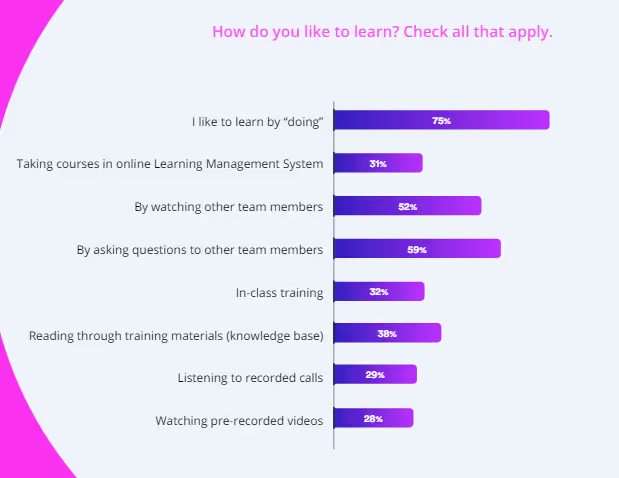Personalization has a great deal of power in the world of sales enablement—for both external and internal sales enablement content.
When you personalize external sales content, you can increase buyer engagement, interest, and retention. And by personalizing internal sales enablement content, you can create learning paths for your sales team that are designed with their needs in mind, boosting their overall motivation and leading them to sales success.
Research suggests that personalizing sales enablement content can make people more interested in learning and more engaged.
In this article, we’ll discuss the different types of internal and external sales enablement content, how to personalize internal sales enablement content, and how Spekit can boost your personalization efforts. We’ll learn from sales enablement expert Keegan Otter, Head of Revenue and RevOps at Warmly, who has spent his career personalizing sales training for optimized learning and growth.
What is Sales Enablement Content?
Sales enablement content is the content that sales teams use to engage with their prospects throughout the sales cycle. This type of content gives sales reps the information and resources they need to reach quota attainment and build better relationships with their prospects. You might also hear the term sales enablement content swapped for sales collateral.
Sales enablement ensures that this type of content is not just made—but is also accessible and available for employees to utilize. Although this content is used by sales teams, it can and should also be accessible to all customer-facing teams, including marketing and customer success, to support all revenue enablement goals. A well-defined approach to building a content strategy ensures that internal and external sales enablement content is structured effectively for maximum impact.
Internal vs external sales enablement content
Internal sales enablement content ensures your sales reps have all the information they need to excel in their roles. This type of content serves various purposes, including keeping reps up to date on product changes, training salespeople on the sales methodologies your sales team uses, optimizing your sales team’s skills like objection handling, and more.
External sales enablement content is content designed by sales and marketing teams to engage with prospects and current customers. This content provides your prospects with information that they need to understand your product or service and leads them toward making a conversion.
Sales Enablement Content Examples
Sales enablement content can encompass many different forms, but here’s a look at the types of content that make up both internal and external sales enablement content:
Internal sales enablement content
- Sales playbooks
- Sales script templates
- Pricing guidelines and breakdowns
- Buyer persona documents
- Win/loss stories
- Sales battle cards
- Competitor comparison and analysis
External sales enablement content
- Blog posts and long-form articles
- Case studies and white papers
- Product spec sheets
- Interactive product demos
- Webinars and explainer videos
- Sales presentations and pitch decks
How to Create Effective Internal Sales Enablement Content
Creating effective internal sales enablement content is a vital part of an impactful sales enablement strategy.
1. Make it personalized
As a sales professional, you probably know the power of personalization in external sales content, with 71% of consumers saying that they expect personalized interactions with brands.
But personalization isn’t just for external content. What works for one person may not work for another—especially when it comes to sales training. By personalizing internal sales content, you’re ensuring everyone has the tools they need to succeed. For example, video is often utilized as training content. Otter has seen how shorter videos have higher retention for younger generations of sales reps, while older reps typically prefer longer videos.
Sales enablement content can be personalized in numerous ways. You can create personalized learning paths during the sales training process, ensuring that your reps see and learn the material that they need and not spend time on topics they may have already mastered. You can also track analytics on your sales rep’s training, where you can gain insight into what topics a rep may need more training on. Personalized sales content management software can help streamline these efforts, ensuring that the right content is delivered to the right reps at the right time. Different content creation methods can be utilized to enhance personalization, making it easier to tailor content to the specific needs of your sales team. Spekit’s Knowledge Checks, short quizzes that pop into your salesperson’s flow of work, can be a handy way to track training success.
2. Learn from your customer
Consider the power of a buyer persona. These personas represent a company’s target audience and break down demographic and firmographic information to form the representation of a particular person who is likely to convert. Research shows that using buyer personas can result in a 175% surge in marketing revenue, a 10% uptick in sales leads, and a 72% reduction in lead conversion time.
Understanding your customers is a vital part of sales training, as it ensures that your sellers are prepared to speak to who your customers are, what their pain points are, and why your product offers the solution they need. Battle cards, sales scripts, and other internal sales enablement content is a perfect place to highlight the uniqueness of your buyer personas and train your team on how to speak to them and their needs.
3. Take advantage of AI
Utilizing AI sales tools is one of the best sales enablement practices today. Artificial intelligence can deliver to your salespeople what you may not be able to do on your own.
Say you wanted your sales reps to utilize the MEDDIC sales methodology. Your rep can simply ask Spekit to write a playbook based on this methodology that they can use for training and utilization purposes, saving you valuable time on having to write and distribute this content yourself.

As Spekit CEO Melanie Fellay notes in the “The Power of Personalization” webinar, documentation of practices and processes is vital. AI removes the manual work of writing this documentation.
4. Measure your successes and make adjustments
Imagine your company in its nascent years. Maybe your sales team was just you. Maybe your marketing was nonexistent. Maybe customer success was one email address. Most likely, as you grow, these company features have greatly changed.
Your product or service has also likely grown, with new features being added and outdated ones being removed. And your target audience may have changed along with them.
Your internal sales enablement content should reflect these changes. Make sure to measure the success of current internal sales enablement content. How are your reps using this content? How often are they using it? By tracking content analytics, you can stay on top of your internal sales enablement content and ensure you’re always finding ways to optimize it.
How to Improve Retainment of Sales Enablement Content
Want to make your sales enablement content go even further? Even the best sales content management software needs effective strategies behind it. Here’s how to boost its power and improve knowledge retention for both your team and their target audience:
Prioritize just-in-time enablement
“You learn a heck of a lot more by doing than just by watching,” says Otter, and studies show that he’s absolutely right. Just-in-time enablement, in which learning content and informative resources are delivered to users right where they are and when they need them most, is a form of “active learning,” which research shows is more impactful than simply watching and listening.
Spekit found that learning by doing is the way sales representatives want to learn the most. That’s why Spekit created an AI-powered platform that instantly delivers enablement when and where your reps need it. From sales enablement training with internal content to AI-powered content recommendations for external content, Spekit delivers what your sales reps need the most right in their everyday workflow.

Courtesy of Spekit’s “The State of Sales Training and Onboarding” Report
Create video content
Otter learned about the power of video content somewhat “by accident” as he studied the content analytics for his personal TikTok. He also noticed a generational divide in how video content is consumed—going back to the importance of personalized content. Otter noticed that shorter videos did well with millennials and Gen Zers, while longer, more explanatory videos did better for Gen Xers and Baby Boomers.
The younger demographic, Otter found, related more to the people he worked with every day, so rather than making long content, he started to make shorter, “high energy” videos with “quick pivots.”
But he also recognized that the needs of his Gen X and Baby Boomer coworkers differed from the younger generations who want those quick cuts. “I’ve learned to kind of separate the two and have more of a ‘Hey, here’s your quick enablement for people that are familiar with Outreach, Salesforce, HubSpot, and then if you’re completely new to these tools, here’s the introduction. The introduction videos are going to be a lot longer because they’re more thorough.”
Otter also notes that the quality of these videos differs as to who is going to watch it, as “millennials and even younger, they’re all about authentic content.” So, those quick-cut videos for younger generations can be filmed faster, edited less, and are generally quicker to produce.
Video can be an effective form of both internal and external sales enablement content. Research shows that 90% of marketers say that video has increased their company’s brand awareness, an important sales enablement metric of external sales enablement content.
And 88% of marketers say videos have increased user understanding of their product or service. A user could be both a customer and a salesperson who needs to understand the product in order to properly sell it. When Otter creates internal sales enablement content for his team—90% of the content is video.
Drive repetition and reinforcement
Repetition and reinforcement tie directly into retention. “You go to an amazing speech, you go to an amazing seminar,” says Otter, “you’re only going to retain 30% of that.”
Fellay knows from experience that people don’t remember information the first time they see it, which is what is known as the “forgetting curve.” She notes that, after six days, that 30% drops to 10%.
“It takes repetition for your short-term memory to transfer that information to your long-term memory,” says Fellay. “So unless it’s reinforced, repeated, and practiced, lack of repetition means people are going to forget it.”
Fellay’s findings relate to the long-time sales and marketing concept of the Rule of Seven, which has found that it generally takes seven touchpoints with a potential customer to result in a conversion, enhancing recognition and improving information retention with every touchpoint. While this concept is often applied to marketing, it can be used in anything in which retention is required, such as sales training.
Spekit uses just-in-time learning to reinforce information and boost retention. Spekit delivers Speks right into your salesperson’s workflow. These bite-sized bits of learning reinforce knowledge and also help them gain a contextual understanding of that knowledge as the Spek arrives right on the tools they’re already using every day. Then, with Spekit’s Knowledge Checks, which are also delivered just in time, they can test what they’ve learned, reinforcing essential concepts.
Make it insanely easy to access
Making content and answers easy to access was one of the driving forces behind the creation of Spekit. Fellay realized that we could easily find answers to questions by a simple search online. However, Spekit found that sales reps spend a considerable amount of time trying to find answers that should be readily accessible.
Only 10% of poor performers say that they can find the information they need to do their job all the time, whereas 22% of top performers say that they can always find those answers. Spekit’s just-in-time enablement meets reps where they are to deliver the answers they need right when and where they need them.
Imagine if your rep was using Salesforce, which Spekit’s research found is the tool that sales reps typically need the most training on. The rep is unsure about the steps they need to take to qualify an opportunity. Not to worry because they’ll find a Spek right there on the Salesforce CRM that will walk them through how to qualify an opportunity and move a lead down the sales pipeline.







